ajsgna ahgnn
Shared posts
Allogeneic immunity clears latent virus following allogeneic stem cell transplantation in SIV-infected ART-suppressed macaques
The 12 Best Star Wars Books Ever Written
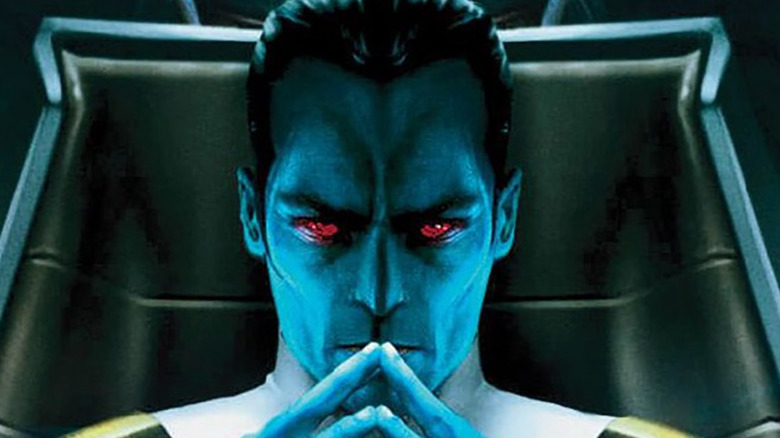
In the "Star Wars" universe, films and television shows may be the big events, but literature has been integral to the franchise since the very beginning. The first piece of "Star Wars" media ever released was the official novelization by author Alan Dean Foster, titled "Star Wars: From The Adventures of Luke Skywalker," which hit bookstores in November 1976, months before the film arrived in theaters. Two years later, Foster returned to pen the first official spinoff novel, "Splinter of the Mind's Eye."
When the prospects of a prequel trilogy were only whispers, "Star Wars" books filled the void for fans. The 1991 release of Timothy Zahn's "Heir to the Empire" told an exciting new adventure that followed the exploits of Luke, Leia, Han, Chewie, Lando, and the droids after the end of "Return of the Jedi." "Heir to the Empire" inspired two sequels, "Dark Force Rising" and "The Last Command," opening up a new era of "Star Wars" publishing in which authors had the freedom to continue the stories of their favorite characters. The prequels created more opportunities, and "Star Wars" authors eagerly delved into the new era, mapping out a history of the galaxy far, far away that spanned over 25,000 years.
Disney rebooted the "Star Wars" timeline in 2013 and kicked off a new wave of "Star Wars" books, relegating the older novels to the non-canon "Legends" line. Still, many of the best "Star Wars" stories ever told are on the page, not the screen. Check out some of the greatest "Star Wars" books ever written.
The Darth Bane Trilogy
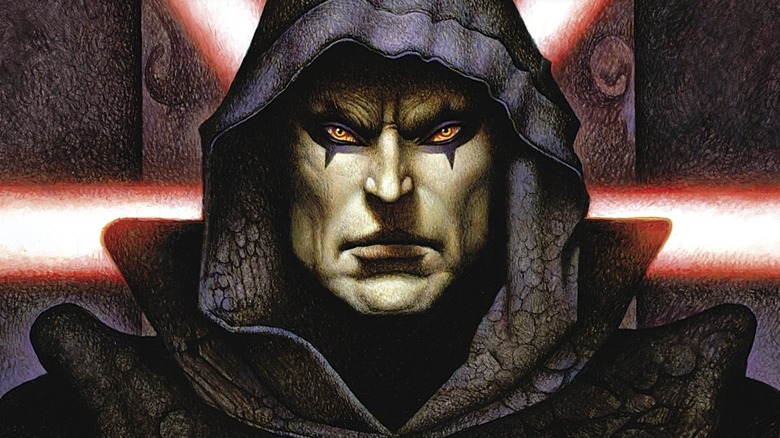
Set one thousand years prior to the events of "The Phantom Menace," the Darth Bane trilogy tells the life story of a pivotal Sith lord. Bane was a grizzled miner who discovered his aptitude for the dark side and joined the ranks of the Brotherhood of Darkness, an army of Sith that waged a war against the Galactic Republic and the Jedi Order. While he relished the chance to join the group, Bane grew concerned that the competing Sith lords were too obsessed with securing power to rule the galaxy.
Bane devised the Rule of Two that George Lucas himself introduced in "The Phantom Menace." Under Bane's law, the Sith were limited to a single master and one lone apprentice. In the novels "Path of Destruction," "Rule of Two," and "Dynasty of Evil," Bane plots the downfall of both the Jedi and Sith and trains an apprentice, Darth Zannah. As a result of Bane's rule, Zannah plots to assassinate her master and take on an apprentice of her own.
The trilogy concludes the Old Republic era of the "Star Wars" timeline and initiates the thousand years of peace that precede "The Phantom Menace," during which the Jedi Order ended their involvement with the military, thinking that they had defeated the dark side.
Master And Apprentice
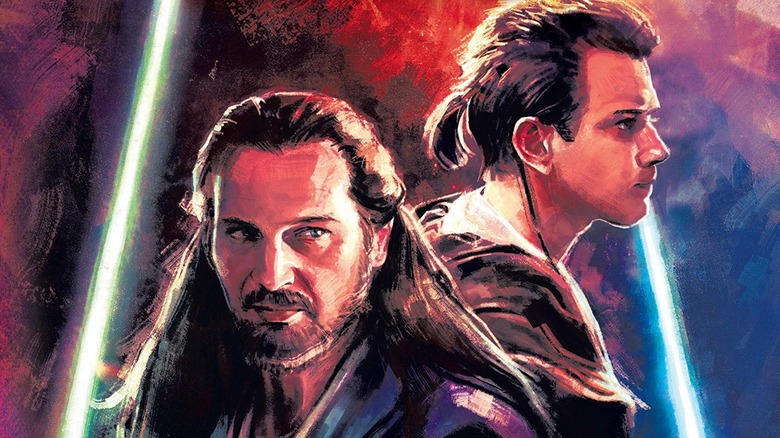
While Qui-Gon Jinn and Obi-Wan Kenobi had a mature and understanding relationship by the time of "The Phantom Menace," the early days of their partnership were anything but smooth. The maverick Qui-Gon was generally adverse to following the strict Jedi code, while his apprentice was a stickler for routine who struggled to connect with his strong-willed master. Claudia Gray's canon novel "Master and Apprentice" details an early adventure that brought the two closer together.
Qui-Gon is approached by Yoda with an invitation to join the Jedi Council; while Yoda himself does not approve of letting the troublesome master into the Jedi's inner circle, the other Jedi feel that Qui-Gon's unique perspective is needed. However, joining the council would force Qui-Gon to hand Obi-Wan's training to another Jedi master, a prospect that shatters his apprentice's heart. Obi-Wan feels that he is finally starting to connect with his austere master, and fears disappointing him.
As Qui-Gon contemplates the decision, the two are dispatched on a mission to the planet Pijal, where a young ruler is threatened by an emerging terrorist organization. The assignment reunites Qui-Gon with another untraditional Jedi, Rael Averross, who lost his own padawan in a tragic skirmish. It's a thrilling adventure that fleshes out the interesting Qui-Gon and Obi-Wan dynamic; Obi-Wan's training was featured in the YA series "Jedi Apprentice," but few "Star Wars" books for older readers have covered this period.
Darth Plagueis
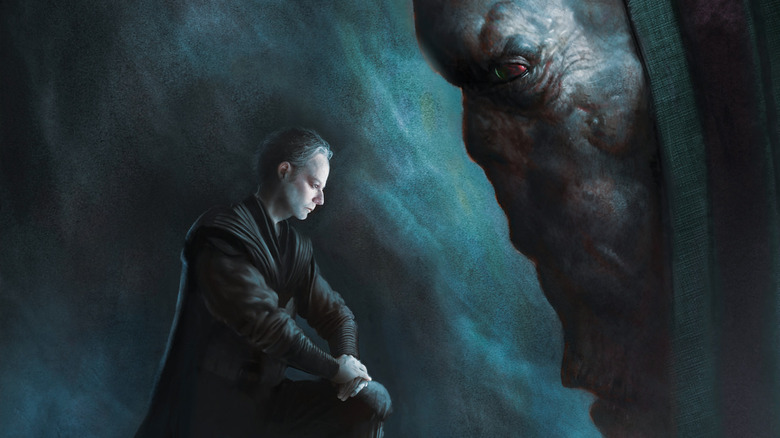
The tragedy of Darth Plagueis the Wise is featured in one of the most iconic scenes in the Star Wars prequel trilogy, but it's not just a story. The Expanded Universe revealed that Plagueis was a real Sith Lord, and that Palpatine was the apprentice who killed him. James Luceno's novel "Darth Plagueis" exposes the secret history of how Plagueis slew his own master, Darth Tenebrous, and became obsessed with studying midi-chlorians, with the ultimate goal of creating life.
Plagueis courted a younger Palpatine when he was still a politician on Naboo, only just discovering his Force abilities. Plagueis used Palptaine's political connections to infiltrate the Galactic Republic and led the InterGalactic Banking Clan under his public persona, Magister Hego Damask II. Together, Plagueis and Palpatine plant seeds of disillusionment in the government and stage the downfall of Supreme Chancellor Valorum.
Plotting to elect Palpatine as the Supreme Chancellor, Plagueis helps initiate the deals with the Trade Federation that lead to the conflict in "The Phantom Menace." However, Palpatine plots against his master by training the young warrior Maul as an assassin and seducing the Jedi Dooku to the dark side. After promising to make Plagueis his co-chancellor upon election, Palpatine betrays Plagueis and kills him in his sleep. Palpatine then continues Plagueis' exploration of the Force's ability to prolong life, aiming to make himself immortal.
Shatterpoint
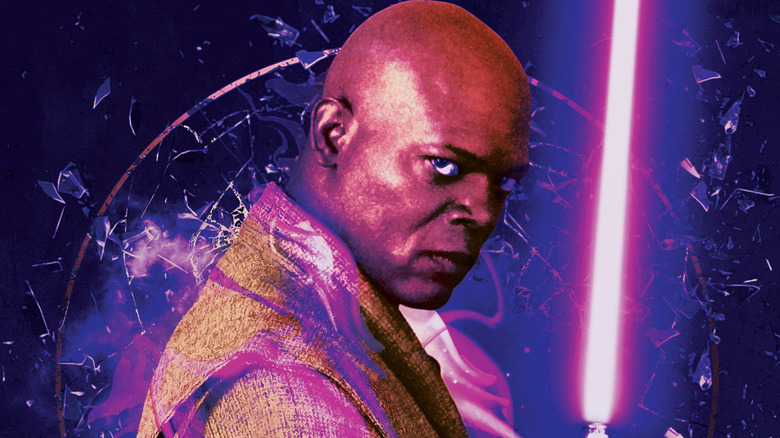
Mace Windu, Yoda's second-in-command on the Jedi Council, starred in this Clone Wars-era novel that saw him return to his homeworld. Mace Windu was raised on Haruun Kal, a planet torn apart by a conflict called the Summertime War, which was fought between natives and outworlders. Windu remembers little of his past, but asks for the assignment when his former padawan, Depa Billaba, goes missing on the planet.
Set only months after the conclusion of "Attack of the Clones," Windu is full of doubt. He's baffled that a galactic war was able to break out so quickly, and worries that Billaba has turned to the dark side, exposing another one of the Jedi's blind spots. Although Windu is known for his restraint, he fights for a personal cause when the Separatist fleet attacks the place where he was raised.
"Shatterpoint" offers a rare window into Windu's mental state, as he keeps journals and wonders if Anakin truly is the Chosen One. While writing, author Matthew Stover was inspired by the classic Vietnam film "Apocalypse Now," which, coincidentally, George Lucas himself had initially planned to direct.
Jedi Trial

One of the most important story developments between "Attack of the Clones" and "Revenge of the Sith" is Anakin's trial to become a Jedi Knight. The Clone Wars-era novel "Jedi Trial" sheds some light on this critical moment, and proves Anakin's merit as a leader.
Anakin is tasked with a solo assignment to support an abandoned Republic outpost on the planet Praesitlyn. Protected only by a rag-tag group of battle-hardened Republic officers, Anakin must help the understaffed world mobilize as Count Dooku's minion Pors Tonith plots an invasion. Should Praestilyn be overrun with droids, the Separatists would gain access to vital hyperspace routes. Although action-packed, "Jedi Trial" is also heavy on wartime strategy, something not always present in Star Wars novels.
One of the darker books, "Jedi Trial" shows the toll war takes on combatants who don't have Force powers, and Anakin's leadership here explains why the Jedi Council granted him knighthood despite their misgivings about his impulsive attitude.
The Dark Lord Trilogy
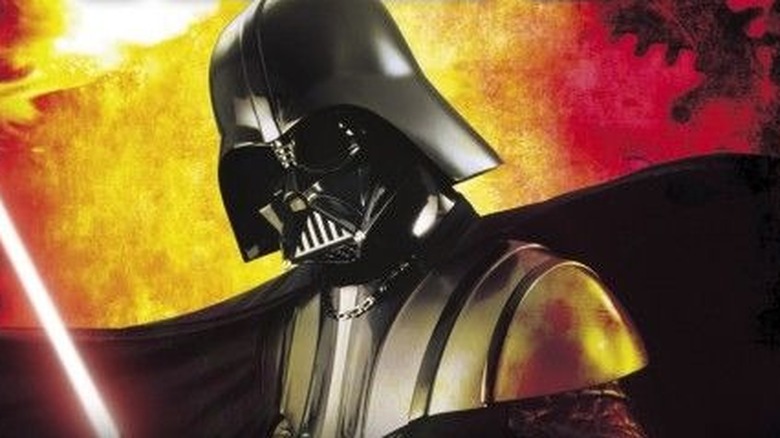
This trilogy of novels follows Anakin's transition into Vader both before and after the events of "Revenge of the Sith." "Labyrinth of Evil" takes place over the last days of the Clone Wars, detailing Anakin and Obi-Wan search for Count Dooku's shrouded master while General Grievous plots to kidnap the Chancellor. Similar to the animated "Star Wars: Clone Wars" micro-series, the novel teases the battle above Coruscant that begins "Revenge of the Sith."
The middle part of the trilogy, Luceno's adaptation of "Revenge of the Sith," is more in-depth than any other Star Wars movie novelization. It includes scenes cut from the film, including Padme's early involvement with the Rebel Alliance. It also details Vader's state of mind as he lies dying on Mustafar, dwelling on his presumed role in Padme's death and his anger towards Obi-Wan. It's a much more satisfying conclusion than the cheesy wail that Vader unleashes in the actual film.
Finally, "Dark Lord" begins in the early days of the Galactic Empire, as Padme's bodyguard Captain Typho searches for the whereabouts of Anakin, presumed missing at the end of the Clone Wars. Meanwhile, Jedi Masters Roan Shryne and Bol Chatak and padawan Olee Starstone manage to survive Order 66, and make an alliance with Chewbacca as the Empire invades Kashyyyk.
The Force Unleashed
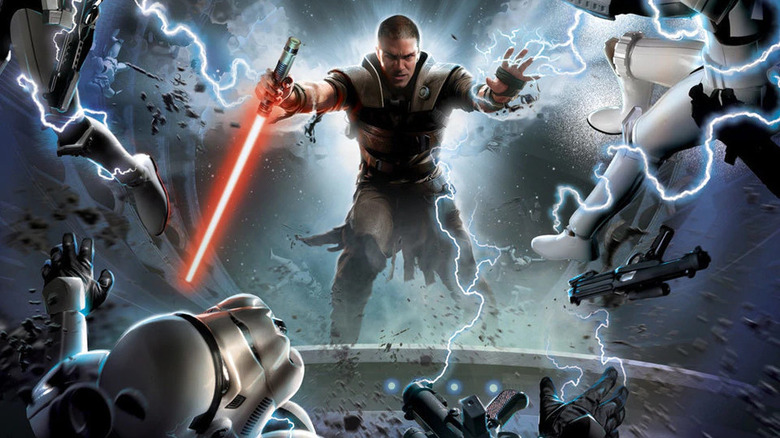
"The Force Unleashed" quickly became one of the most popular "Star Wars" video games of all time, but the story of Darth Vader's secret apprentice wasn't limited to those with a gaming console. Sean Williams penned a novelization that fleshed out the story of Galen Marek, the orphaned child of a Jedi Knight who is trained in the dark side by the Dark Lord of the Sith, and who takes on the codename "Starkiller."
Starkiller is tasked with assassinating the Jedi who survived Order 66, slaying such veterans as Shaak Ti and the ancient hermit Kazdan Paratus. As Starkiller grows closer to his master, Emperor Palpatine suspects the two are plotting his downfall and orders Vader to execute his apprentice. With nowhere else to run, Starkiller turns to his former adversary, Jedi Master Rahm Kota, who begins training him as a Jedi, hoping to make him a leader in the Rebellion.
"The Force Unleashed" retains all the excitement of the game while fleshing out Starkiller's romance with Juno Eclipse, an Imperial pilot who similarly questions her loyalties. Starkiller's shape-shifting droid PROXY provides comic relief, and prior to "Rogue One: A Star Wars Story," the book gave an alternate explanation of how the Rebel Alliance obtained the Death Star plans. Williams also penned the novelization of the sequel "The Force Unleashed 2," which follows Vader's attempts to clone his former protégé.
The Han Solo Trilogy
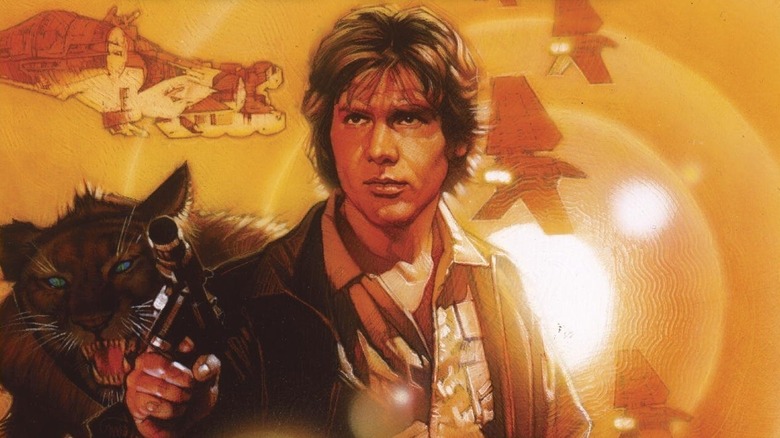
The 2018 prequel film "Solo" borrowed many elements from original Han Solo's backstory, which was first established in a trio of novels from author A.C. Crispin. "The Paradise Snare," "The Hutt Gambit," and "Rebel Dawn," which are now non-canon, told the story of the smuggler's early days as a Corellian outlaw who enlists to become an ace Imperial fighter pilot. As in "Solo," Han becomes disillusioned by the Empire and rescues a mistreated Chewbacca, who swears him a life debt as his co-pilot.
Many of the events in "Solo" first happened on the page, including Han's victory over Lando Calrissian in the card game that won him ownership of the Millennium Falcon. However, some things are different; instead of Qi'ra, young Han falls for Bria Tharen, a wealthy Corellian girl who is unable to come to terms with Han's illegal profession. A heartbroken Han even pilots a ship he christens Bria before he develops a more callous attitude.
Other events diverge from "Solo" and tie more directly to the original Star Wars trilogy. "Rebel Dawn," for example, is about the botched mission that forces Han and Chewie to dump a valuable shipment of spice, angering their employer, Jabba the Hutt. Both fans who loved "Solo" and those who were underwhelmed might enjoy this alternate origin story for the Star Wars universe's most beloved smuggler.
Splinter Of The Mind's Eye
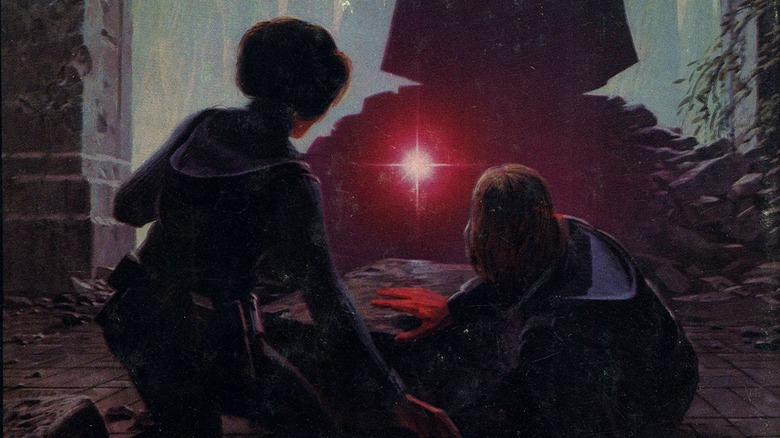
After writing the original novelization of Star Wars, author Alan Dean Foster was hired to write a sequel, "Splinter of the Mind's Eye." George Lucas's plan was to have a second story ready in case "Star Wars" bombed at the box office. If "Star Wars" underperformed, its sets could be reused for a low-budget sequel featuring some of the principal cast members. After the film broke box office records, however, "Splinter of the Mind's Eye" was repurposed as the first spinoff novel.
The book follows Luke, Leia, and the droids as they search the mining colony Mimban for a kyber crystal, which is referred to as a powerful Force artifact. The Expanded Universe would later establish that Kyber crystals are the energy source that powers lightsabers, an idea that has persevered into the Disney era.
The story is bound by the constraints of a smaller film. The locations are mostly murky forests and sets that appeared in the first film, and only Luke and Leia are featured (a return appearance wasn't in Harrison Ford's original contract). Lucas had Foster cut out a space battle that would've been too expensive to film, but the book did feature the first lightsaber battle between Luke and Darth Vader a full two years before "The Empire Strikes Back." There are also hints of a romance between Luke and Leia, as Foster was unaware that they were siblings.
Shadows Of The Empire
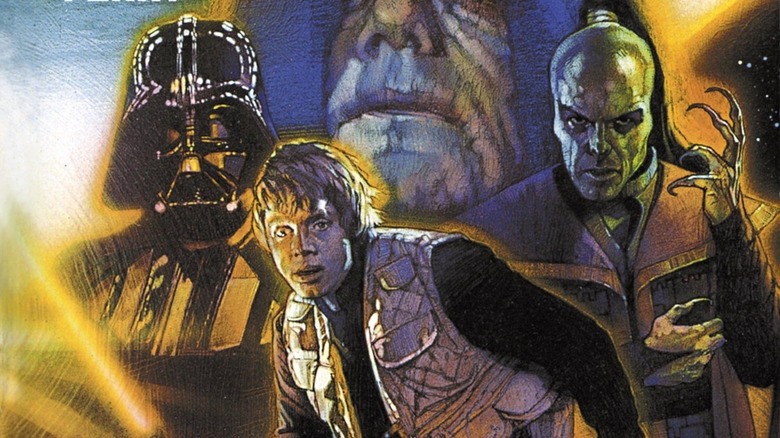
In 1996, Lucasfilm launched the most ambitious project the Expanded Universe had seen yet. Preparing the market for the release of "The Phantom Menace" and the Star Wars Special Editions, a top-tier creative team was tasked with creating a multimedia event that would mimic the year-long marketing campaign surrounding a film. The story group developed "Shadows of the Empire," an interconnected narrative told through a novel, a junior novelization, a video game, a comic book series, a roleplaying game, merchandising, and even an official soundtrack.
"Shadows of the Empire" bridges the gap between "The Empire Strikes Back" and "Return of the Jedi" as Luke, Leia, Chewie, Lando, and the droids search for Boba Fett, who still holds Han as his carbonite-frozen captive. In order to enter the world of "scum and villainy," they enlist the help of smuggler Dash Rendar, an old rival of Han's. The novel also gives insight into Luke's shattered emotions, as he's still processing the revelation that Vader is his father.
"Shadows of the Empire" introduced the Black Sun organization, a powerful crime syndicate that forms an alliance with the Galactic Empire in order to track down Luke. Black Sun's leader Prince Xizor harbors an intense hatred for Darth Vader, who devastated his homeworld of Falleen with a biological weapon, and aims to kill Vader's son out of revenge. Xizor plots to replace Vader as Emperor Palpatine's second-in-command, and energizes the criminal underworld to search for Skywalker.
The Thrawn Trilogy
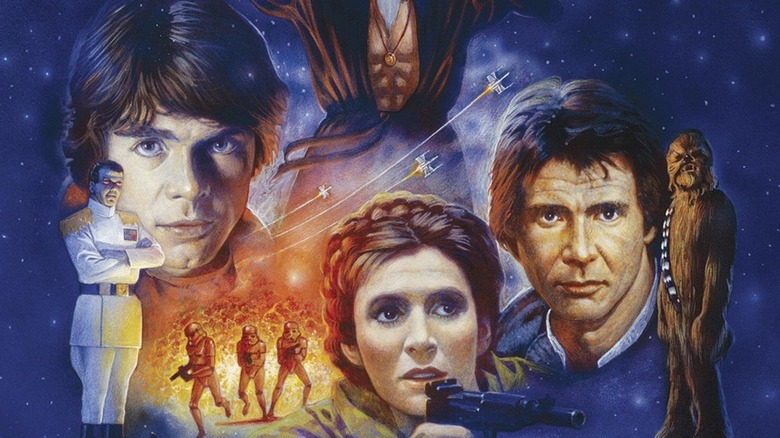
Perhaps the most important Star Wars novel ever written, "Heir to the Empire" kicked off the Expanded Universe. While the post-"Return of the Jedi" era had briefly appeared in the original run of Marvel comics, the period was largely unexplored before Timothy Zahn's novel hit shelves in 1991. The book picks up five years after the destruction of the second Death Star. The New Republic has been established, but its expansion is hindered by the remaining Imperial forces.
Former Imperials unite under the command of Grand Admiral Thrawn, an alien strategist who discovers secrets buried in Emperor Palpatine's personal vaults. Amassing a fleet of ships and unleashing the threat of a crazed former Jedi, Thrawn sets his sights on retaking the former Imperial capital, Coruscant. Thrawn instantly became a fan-favorite character, and made his transition to the new "Star Wars" canon when he appeared in the animated series "Rebels"; rumors suggest that he'll also play a key role in the upcoming show "Ashoka."
"Heir to the Empire" establishes that Han and Leia were married and expecting twin children, Jacen and Jaina, but that isn't the only romance. In "Heir to the Empire," Luke crosses paths with former dark side acolyte Mara Jade, and while the two are initially forced into a shaky alliance, they eventually develop feelings for each other. Mara Jade emerged as a hero in Zahn's sequels, "Dark Force Rising" and "The Last Command."
Lost Stars
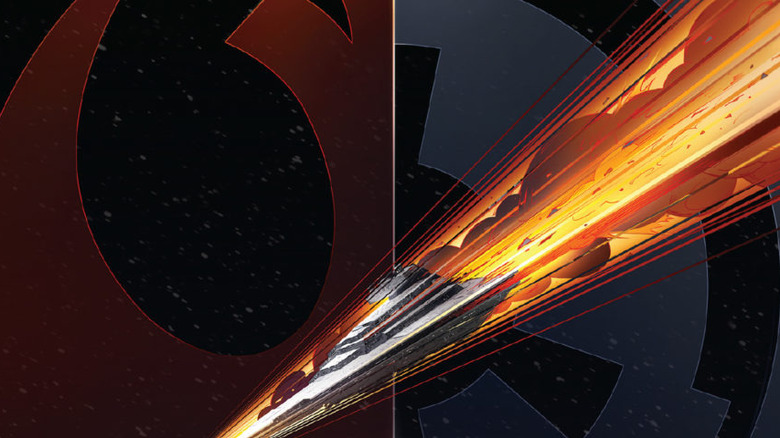
The galaxy far, far away is filled with action and intrigue, but there's also room for romance. The canon novel "Lost Stars" follows the tragic story of two Outer Rim children who bond at an early age when their homeworld, Jelucan, joins the new Galactic Empire. Thane Kyrell and Ciena Ree are inseparable, dreaming of leaving their home planet behind and joining the Imperial Academy to become TIE pilots.
At first, the Empire seems like an exciting alternative to the underdeveloped farmlands of Jelucan, and the pair even earns an audience with Grand Admiral Tarkin. The two become heroes in their own rights as they rise through the Imperial ranks, but soon the deadly consequences of the Empire's expansion nag at Thane. After learning about the Death Star's power, Thane considers joining the Rebel Alliance; a critical meeting with Wedge Antilles seals his decision. Unfortunately, this means joining the side opposite his lifelong crush.
"Lost Stars" reimagines the events of the original trilogy from the perspective of those on the fringes of the story. It's interesting to see how Imperial propaganda mischaracterizes the Rebel Alliance, and how noble people like Ciena are deceived into aiding the Empire and destroying innocent lives. Although it's classified as a YA novel, "Lost Stars" is a great read for any fan looking for a new take on the Star Wars universe.
Read this next: The 10 Most Essential Episodes Of 'Star Wars Rebels'
The post The 12 best Star Wars books ever written appeared first on /Film.
Tissue-resident CD4+ T helper cells assist the development of protective respiratory B and CD8+ T cell memory responses
Much remains unknown about the roles of CD4+ T helper cells in shaping localized memory B cell and CD8+ T cell immunity in the mucosal tissues. Here, we report that lung T helper cells provide local assistance for the optimal development of tissue-resident memory B and CD8+ T cells after the resolution of primary influenza virus infection. We have identified a population of T cells in the lung that exhibit characteristics of both follicular T helper and TRM cells, and we have termed these cells as resident helper T (TRH) cells. Optimal TRH cell formation was dependent on transcription factors involved in T follicular helper and resident memory T cell development including BCL6 and Bhlhe40. We show that TRH cells deliver local help to CD8+ T cells through IL-21–dependent mechanisms. Our data have uncovered the presence of a tissue-resident helper T cell population in the lung that plays a critical role in promoting the development of protective B cell and CD8+ T cell responses.
‘The Girl With the Dragon Tattoo’ Standalone Series in the Works at Amazon
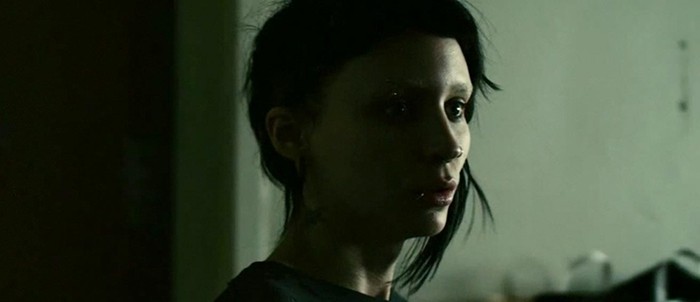
We haven’t seen the last of Lisbeth Salander.
The skilled computer hacker, best known as the title character in Steig Larsson’s The Girl With the Dragon Tattoo novels and the subsequent movie adaptations, is going to be the subject of a standalone TV series at Amazon.
Variety reports that Amazon is developing a series centering on Lisbeth Salander, the hacker protagonist of the Millennium books. The outlet says that this show “will not be a sequel or continuation of the story from the books or the films into which they were adapted,” but will instead put Salander “in today’s world with a wholly new setting, new characters, and a new story.” (The original Girl With the Dragon Tattoo novel took place in the early 2000s.)
Andy Harries (The Queen, The Crown, Strike Back, Outlander) and Rob Bullock (The Night Manager, Origin) will executive produce the series, and Amazon Studios will produce with Sony Pictures Television. No writer is attached yet, so it’s tough to judge how this standalone series could shake out. But for me, it’s a promising sign that the decision has been made to center the show on Lisbeth herself and not try to adapt another of the novels, several of which were written by another writer after Larsson’s death in 2004. Lisbeth, the world-class hacker with an avenging angel streak in her, is the big draw here, and it’ll be interesting to see if Harries, Bullock, and this show’s eventual writer can rejuvenate the public’s interest in this character after the last movie flopped hard at the box office. (Just spitballing here, but maybe try to hire a female writer? This character has a traumatic backstory that could easily be fumbled in the wrong hands, and while it would be idiotic to suggest that it’s impossible for men to write about a woman’s experience, I’m just saying it probably wouldn’t hurt to have a female perspective behind the scenes.)
The character was last played on the big screen by Claire Foy in Fede Álvarez’s 2018 adaptation of The Girl in the Spider’s Web, which cost $43 million to make but earned only $35 million worldwide. (Not great, Bob.) Previously, Lisbeth Salander had been played by Rooney Mara in David Fincher’s 2011 adaptation of the first book, and, before that, by Noomi Rapace in her star-making role in the 2009 Swedish-language film trilogy. No actress has been specified for this iteration, although big name actresses like Natalie Portman and Alicia Vikander previously auditioned for the part in earlier movies, so it seems likely the role will attract lots of A-list attention this go-around, too.
The post ‘The Girl With the Dragon Tattoo’ Standalone Series in the Works at Amazon appeared first on /Film.
Single-cell transcriptome analysis reveals differential nutrient absorption functions in human intestine
Single-cell transcriptome analysis of epithelial cells from human ileum, colon, and rectum reveals different nutrient-absorption preferences in the small and large intestine, providing a rich resource for further characterization of human intestine cell constitution and functions.
Interstitial-resident memory CD8+ T cells sustain frontline epithelial memory in the lung
Tissue-resident lung memory CD8+ TRM cells in the lung interstitium and airways are compartmentally separated from TEM cells, and lung airway TRM cells are primarily maintained by the continuous seeding of cells from the lung interstitium.
mRNA Degradation Rates Are Coupled to Metabolic Status in Mycobacterium smegmatis
The success of Mycobacterium tuberculosis as a human pathogen is due in part to its ability to survive stress conditions, such as hypoxia or nutrient deprivation, by entering nongrowing states. In these low-metabolism states, M. tuberculosis can tolerate antibiotics and develop genetically encoded antibiotic resistance, making its metabolic adaptation to stress crucial for survival. Numerous bacteria, including M. tuberculosis, have been shown to reduce their rates of mRNA degradation under growth limitation and stress. While the existence of this response appears to be conserved across species, the underlying bacterial mRNA stabilization mechanisms remain unknown. To better understand the biology of nongrowing mycobacteria, we sought to identify the mechanistic basis of mRNA stabilization in the nonpathogenic model Mycobacterium smegmatis. We found that mRNA half-life was responsive to energy stress, with carbon starvation and hypoxia causing global mRNA stabilization. This global stabilization was rapidly reversed when hypoxia-adapted cultures were reexposed to oxygen, even in the absence of new transcription. The stringent response and RNase levels did not explain mRNA stabilization, nor did transcript abundance. This led us to hypothesize that metabolic changes during growth cessation impact the activities of degradation proteins, increasing mRNA stability. Indeed, bedaquiline and isoniazid, two drugs with opposing effects on cellular energy status, had opposite effects on mRNA half-lives in growth-arrested cells. Taken together, our results indicate that mRNA stability in mycobacteria is not directly regulated by growth status but rather is dependent on the status of energy metabolism.
IMPORTANCE The logistics of tuberculosis therapy are difficult, requiring multiple drugs for many months. Mycobacterium tuberculosis survives in part by entering nongrowing states in which it is metabolically less active and thus less susceptible to antibiotics. Basic knowledge on how M. tuberculosis survives during these low-metabolism states is incomplete, and we hypothesize that optimized energy resource management is important. Here, we report that slowed mRNA turnover is a common feature of mycobacteria under energy stress but is not dependent on the mechanisms that have generally been postulated in the literature. Finally, we found that mRNA stability and growth status can be decoupled by a drug that causes growth arrest but increases metabolic activity, indicating that mRNA stability responds to metabolic status rather than to growth rate per se. Our findings suggest a need to reorient studies of global mRNA stabilization to identify novel mechanisms that are presumably responsible.